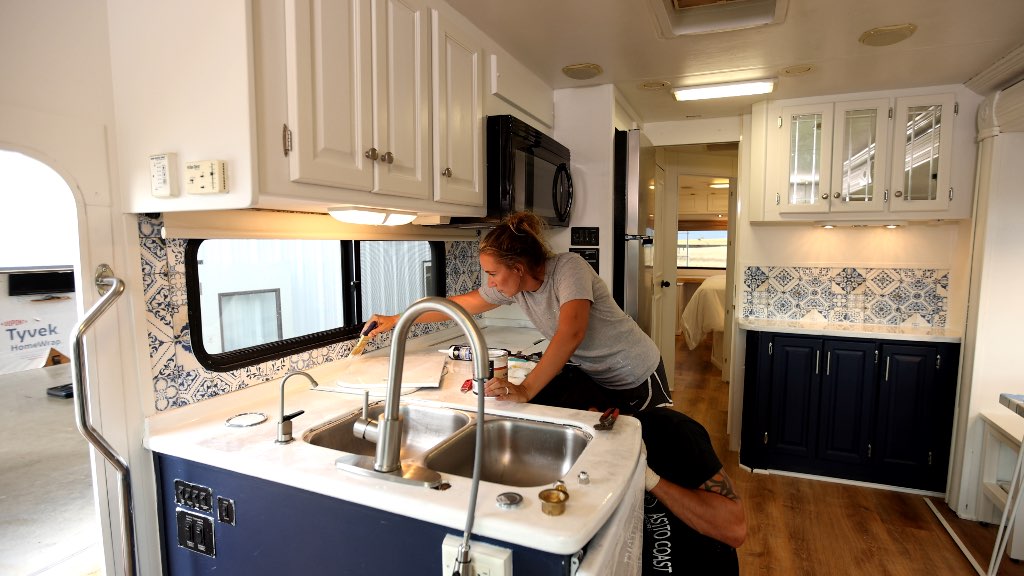Tech Q&A — October, 2023
A CAT Saver, a Noisy A/C, a Chassis-Brake recall, and Boosting Wi-Fi Signals
Image Caption:
Catalytic Converter Theft
Q: We have a 2009 Winnebago Spirit motorhome. Is there anything on the horizon to help with the nationwide problem of catalytic converters being stolen? I’m sure the vehicle manufacturers and motorhome companies are aware of this ongoing issue. There needs to be a major discussion to help with this issue and shared with repair shops to protect the owners from this problem.
—Ricky L. James, Whitehall, Pennsylvania
A: Catalytic converters contain precious metals such as platinum, palladium, and rhodium, which are valuable and can be recovered from old catalytic converters, which is why their scrap value is so high. Thieves can make thousands of dollars per night stealing catalytic converters, and the replacement costs are many times higher.
Motorhomes are easy targets because they have large valuable cats, are often parked in storage lots, and sit high off the ground, so it’s not necessary to jack them up to remove catalytic converters. There are a number of products, including shields (such as the CatClamp), that make it difficult for thieves to steal them.
You can do an internet search for “antitheft device for catalytic converter,” and many items will show up. Muffler shops can also sell you the parts and install them if needed. In addition, there are some add-on alarm units that might scare off thieves. I recommend using both.
Ford F-53 Chassis Brake Recall
Q: I saw in the July issue that you listed a recall for RAM 1500 pickups. I suggest that you look up recall #23V-164, which applies to potentially 644 Ford F-53 chassis. The recall involves the rear brake calipers. After many years of owning a 2007 Monaco Cayman, on June 14, 2023, my wife and I decided to purchase a new 2023 Entegra Vision 36C from La Mesa RV in Sacramento, California.
The coach is beautiful, but it is built on an F-53 chassis impacted by the recall. We did not know of, nor did La Mesa tell us about, the recall prior to delivery of the coach. On our drive home from La Mesa RV in Sacramento to our home in Lafayette, California, we noted that the dash A/C was not working properly. At home, we checked the A/C and determined that there was a mechanical issue and not an operator error. We immediately called La Mesa and told them of the issue with the A/C. We were able to get an appointment with La Mesa Service in Dixon, California.
Additionally, on our drive home, I noted that the brakes were not as effective as the air brakes we had on our previous Monaco. The brakes on the Entegra are vacuum-assist hydraulic discs and felt somewhat “spongy.” This issue was added to a list of items for La Mesa to check during the scheduled service. At the La Mesa service facility, we told the service advisor of our concern about the brakes.
We were shocked to hear that even with a huge service facility, La Mesa refused to even inspect the brakes. They told us to take the coach to a Ford dealer for that service. Once again, they did not mention that there had been a recall on F-53 chassis brakes since March 10, 2023. We left our coach for the A/C repair.
I checked the internet for issues with Ford F-53 brakes and found the recall report. California law requires RV dealers selling “new” vehicles to correct a recall prior to sale. The correction was not done on our Entegra, nor was the recall ever mentioned. Your readers, who have a motorhome built on a Ford chassis, should be alerted to the recall. The resolution to our specific issue is still pending. We like the coach; we just want it properly repaired.
—John and Donna Kaehms, Lafayette, California
A: This recall affects only 343 Ford 2022 F-53 chassis, which were built between October 24 and November 29, 2022. The rear brake caliper bolts may not have been tightened properly to the required torque. These affected vehicles are not produced in VIN order. Owners can call Ford’s toll-free line (866-436-7332) or contact a local Ford dealer, who can look up the vehicle using the Ford On-line Automotive Service Information System (OASIS) database. This will require the specific VIN.
Regarding your dealer visit, I suspect that they have a policy to direct safety-related owner concerns, such as brakes, to an authorized Ford dealer, particularly on newer vehicles that are covered by Ford’s chassis warranty. Recalls must be done by an authorized dealer in order to officially clear and close the recall.
Vacuum-assist hydraulic disc brakes have a totally different pedal feel compared to air brakes, and it could be characterized as feeling spongy. You might want to drive another similar coach like yours to compare pedal feel.
If your RV’s chassis is one of the 343 to be within the recall (Ford states that only about 2% of these actually have the problem) and you feel strongly enough about it, you could report the selling dealer to NHTSA or the California Bureau of Automotive Repair for failure to clear the recall before sale.
Air-Conditioning Noise
Q: My wife and I purchased a Class C 2022 Thor Freedom Elite 22-foot motorhome, and we absolutely love traveling in it. The problem is the Coleman Mach air-conditioning unit, which is roof-mounted and accessible through the ceiling. The fan is loud and drowns out all other noise in the motorhome, such as the television and conversations. Are there any solutions to quiet down the system, or is there an upgrade to a quieter system?
—Tony Perry, Elizabeth City, North Carolina
A: You are not the first person to notice this problem, but you are in luck as there are several solutions. Here is a YouTube video titled Quiet and Enhance Airflow On Your RV A/C—the Coleman Mach.
WackO Products also makes a kit to reduce noise; it’s available through Camping World and other outlets you can find online.
Some of the new air conditioners on the market are designed to be extra quiet and often draw less current than their older counterparts. The Truma Aventa, for example, is remarkably quiet. It’s more costly but may be the answer to the problem.
Electrical Draw
Q: My 2023 East to West Entrada 2200S motorhome has an electrical drain coming from the coach, according to the Ford dealer. It’s draining the engine battery with a 0.23-amp draw. The open circuit is at fuse 97, which is for customer access. Any insight as to what this is for? General RV says it had an open circuit coming from the engine side of the RV and no open circuits in the coach. That’s why I took it to Ford.
—Bill Fader, Strongsville, Ohio
A: If there is a current draw at fuse 97, which is designed for add-on devices such as radios, remove that fuse and see what doesn’t work anymore. At 0.23 amps, it could be a small light bulb, such as a compartment lamp or a circuit board, or a combination of several keepalive memory circuits, such as a radio, etc. If an electrical draw from the coach is discharging the engine’s battery, that should be the responsibility of the coachbuilder and, as a 2023 model, should be covered under warranty. East to West is a subsidiary of Forest River, and warranty contacts are listed on the website; in your case, you can call 574-264-8051 or email [email protected].
As for terminology, a current draw is not an open circuit, as an open circuit, by definition, does not have any current flowing (think of a broken wire or switch in the off position as an open circuit).
Soon afterward, I received another email from Mr. Fader with a follow-up on the battery drain. He stated, “The wire that is for the radio memory presets went to the accessory wire, and radio power went to the battery. My chassis radio was wired wrong right from the builder.” This should have been covered by the coach warranty.
Running Air Conditioner on Batteries
Q: We have a 2022 RAM ProMaster Thor 20K Sequence Class B motorhome. When we travel, we like to stay in rest areas. At night we run the air conditioner off an inverter hooked to the house batteries to cool down the coach, but this can only run for a few hours, and then the house batteries are depleted. The next night the solar panel has not replenished the batteries, and we are without any power to the coach for our next night’s stay. I have considered buying more batteries and hooking them up in parallel or purchasing a solar generator. I am unsure of which way is best or if either of these ideas will work, how to make them work, or which brand is best to purchase.
—William Daly, Vero Beach, Florida
A: Running the air conditioner off an inverter hooked to the batteries is way too hard on gel/lead-acid batteries, which should never be discharged below 50% of their rated capacity. This will ruin the batteries in short order. If the coach has lithium batteries, they can be discharged deeper, but the engine alternator also should be charging the house batteries.
According to Thor, when the batteries are depleted that far, you have to plug in to shorepower to get them up to approximately 40% in order to have the engine alternator replenish the batteries to full capacity. That can also be done with 120-volt AC power from a portable generator. I recommend that you get a compact portable inverter generator to run the air conditioner. Highway rest areas are typically quite noisy, and there shouldn’t be an issue running a quiet generator.
The so-called “solar generator” does not produce power like a gasoline generator; it just stores electricity in internal lithium batteries. That power has to come from somewhere, such as solar panels, a gas generator, or a shorepower connection, and the battery power passes through an inverter to produce 120 volts AC, but it’s not enough to run an air conditioner. Extra batteries are good, but I’d especially recommend more solar panels to help the batteries catch up during the day.
Propane Article
We have a Holiday Rambler 38PBDD diesel motorhome. In a recent article pertaining to propane (“Cooking With Gas,” July issue), I believe there was one omission. This is my personal experience with a propane problem I experienced in zero-degree weather.
When we were in the process of preparing to depart for warmer climates, I found that the furnace would not fire up. In contacting a local RV repair facility, I was advised that they were unable to help me out as they were already overbooked. They advised me to check the propane pressure. Because I had no way of performing such a check, they suggested that I turn on the cooktop and turn on the furnace. If the flame significantly decreases when the furnace fires up (or, in my case, tries to fire up), then there is a propane pressure problem. Performing this test indeed indicated a pressure issue.
I first replaced the regulator. This did not correct the pressure issue, as the new regulator had no effect. I then removed the hose connecting the regulator to the distribution manifold. The hose was full of the oily substance from the propane gas. I flushed out the hose with hot water and then blew out the hose with air pressure.
I reassembled the hose from the new regulator to the distribution manifold and performed the suggested test. The flame on the cooktop remained bright and steady, and the furnace fired up. The oily substance had accumulated and restricted the ow of gas. I hope this helps someone experiencing a similar problem. It’s a simple item that really works.
—Bob Moenart, Pinckney, Michigan
A: Thanks for writing, Bob. This will likely help a number of folks who read this. James Adinaro did a great job and fit a lot into a short article. However, it seems there’s always one more possible item to cover. I have run into a propane blockage, like you mentioned, which was caused by propane oil in a low spot of the line.
Reader Tip
This is in regard to your reader’s question in the May issue about signal boosters. This can get a bit complicated as bad or slow connections can be caused by many possibilities. But for connecting to the RV park’s Wi-Fi …
The usual problem can be, especially in older RVs, the exterior sheathing is metal and metal blocks Wi-Fi signals. Also, the RV park’s access point (AP) may be distant and/or blocked by trees and thus weak.
Third, wireless communications are by antennas, and antennas receive signals that have orientations (called polarization). If the antenna is not oriented in line with the park’s antenna, you’re going to get a weak signal. And the antenna most likely is internal to your laptop, so it’s weak, and there’s no practical way to reorient it.
To solve all that, the first and least expensive solution for one user is to buy an external Wi-Fi adapter that can be plugged into a laptop via USB cable, so you can situate and orient it as desired. Then, sit in front of a window where the signal’s least likely to be blocked and play around with the orientation. A good starting choice would be a TP-Link T9UH wireless adapter for around $60.
There are other more expensive and elaborate multiuser solutions, but they generally require roof mounting and running a power cable through the roof. In a more detailed answer, I’d probably recommend, for multiuser, a Ubiquiti BULLET-M2-HP outdoor access point. But that would require a lot of explanation, plus networking knowledge and experience to install and use.
I hope this helps.
—Kent Barbour, San Francisco, California
A: Thank you for this helpful information, Kent. I’m sure many readers will find it useful. Many of us rely on internet access to keep in touch with family and business contacts.
Have a Question?
Looking for answers on all things RV, including systems, engines, accessories, or construction? Submit it to our expert at [email protected] and it may be selected for publication. You must include your name, city and state, phone number (will not be published), and type and model of your RV.





